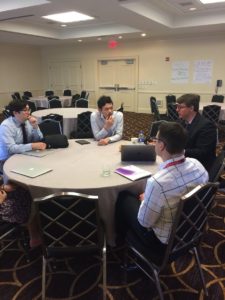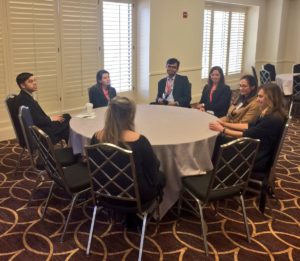This March in New Orleans, the Council on Epidemiology and Prevention with the Council on Lifestyle and Cardiometabolic Health hosted the 2018 EPI Lifestyle Scientific Sessions. A great part of the early career programming this year were the Connection Corners. Small roundtable discussions led by two established investigators drew early career attendees to learn about grant writing, crafting effective elevator speeches, and improving their curriculum vitae (CV). I was lucky enough to listen in (while snapping photos and live tweeting the conversation) and have some highlights to share.

Drs Brooke Aggarawal and Mercedes Carnethon talk with early career investigators about crafting your elevator speech at AHA Epi Lifestyles 2018 in New Orleans.
Practice your Elevator Speech
Dr. Brooke Aggarawal and Dr. Mercedes Carnethon
An elevator speech is a 30-second “pitch” or summary named for when you find yourself in an elevator with a stranger, and they ask “What do you do?” Of course, you could encounter that question in many scenarios that necessitate an engaging, brief, and understandable response.
Dr. Brooke Aggarawal and Dr. Mercedes Carnethon had a variety of advice on how to develop your pitch, as well as some unique ideas. Dr. Carnethon’s biggest takeaway was to have several elevator speeches – one for each research topic, as well as one for various scenarios.
- Brainstorm situations you may need an elevator speech
- Family gatherings and dinners
- Social gatherings with new friends
- New colleagues at a conference
- On an interview
- In an elevator
- Outline your research topics – maybe you study cardiovascular disease, but with a focus on sleep, or diabetes, or congenital abnormalities. You probably have a project or two that goes along with each of those topics.
The first step is to write down your speech and then simplify the details into one message per pitch. That means all the details and objectives and methods you might explain to your mentor or at a poster presentation won’t have a place in this elevator speech.
Dr. Brooke Aggarawal had some great advice. Avoid using jargon and be concise while still answering the question “So what?”. And the answer to “So what?” will be different depending on who you’re talking to.
When simplifying your project into a single method, you may try to:
- Develop analogies that paint a picture for your listener
- Open and/or close with a question that piques their interest
And lastly, practice practice practice! Especially if you’re preparing for an interview, this answer to “tell us about yourself” should roll of the tongue and demonstrate your passion for your research.

Drs.Christopher Imes and John Wilkins talk to early career investigators about “Boosting Your CV” at AHA Epi Lifestyle 2018 Connection corner.
Boosting Your CV
Dr. Christopher Imes and Dr. John Wilkins
This Connection Corner was all about how to get your message across quickly and concisely in your curriculum vitae. Just like with resumes, your CV is typically skimmed by the reader, and despite the traditional format, there are some steps you can take to stand out.
Dr. John Wilkins pointed out that you should utilize the librarians – experts in information sciences – at your institution to summarize your “research impact”. They can do searches that summarize your publications, citations, etc. that you can include in a biosketch intro that precedes your CV. Plus, a biosketch is the ultimate way to make sure the first thing the reader sees is the message you want them to!
The laptops came out and Dr. Imes and Dr. Wilkins read and provided feedback on CVs for early investigators at various levels – PhDs, post-docs, and early career professors. The last point they drove home was that while it may seem inconsequential, pristine formatting and grammar is imperative in your final draft. Typos and bad spelling leave a bad impression that can move your CV to the “no” pile before they even finish reading it.

Drs. Norrina Allen and Deepak Gupta field questions at AHA EPI Lifestyle 2018 about grant writing.
Specific Aims
Dr. Norrina Allen and Dr. Deepak Gupta
The group around the table at the grant writing Connection Corner was an accomplished one! With 4 K-awards submitted or about to be between them, they had plenty of questions for Dr. Norrina Allen from Northwestern and Dr. Deepak Gupta from Vanderbilt.
The two main points of the discussion were to craft your career development plan in a way that conveys responsibility, innovation, and prospect to the grant readers, as well as:
Mentoring questions were a big part of this discussion. One person asked, “Should your K-award mentor be someone you’ve worked with before, or someone in the field you’re aiming to get new training in?” Drs. Allen and Gupta answered – definitely someone you have a connection with. They explained that the primary mentor on your K-award is for the career development, while the training goals you set will be met with the network of content and methods experts you put together. Similarly, they noted that the aims for your K grant should match the training domains you want to achieve.
Drs. Allen and Gupta emphasized that for career development grants, it’s important to be specific in your career trajectory section about how that grant is a stepping stone for your future goals. They mentioned being particularly impressed when grant writers state how that K-award (for example) will set them up to submit an R01 on topic “<enter Title>” in year # of their career development award. While you don’t need that R01 grant written up in your head, having an idea of the title and the timeline shows planning and promise.
Lastly, the classic question: How many aims should you have? The answer, like many things, is that it depends. Too many aims, or aims that are too diverse, will water down the focus of your overall proposal. The aims you craft need to be achievable during the time period, concise and straight forward, and should not be interdependent on one another, whether the success of one depends on the success of another.
If you couldn’t be there in person, I hope these pearls of wisdom were the next best thing! What’s on your to do list for career development this month?

Bailey DeBarmore is a cardiovascular epidemiology PhD student at the University of North Carolina at Chapel Hill. Her research focuses on diabetes, stroke, and heart failure. She tweets @BaileyDeBarmore and blogs at baileydebarmore.com. Find her on LinkedIn and Facebook.